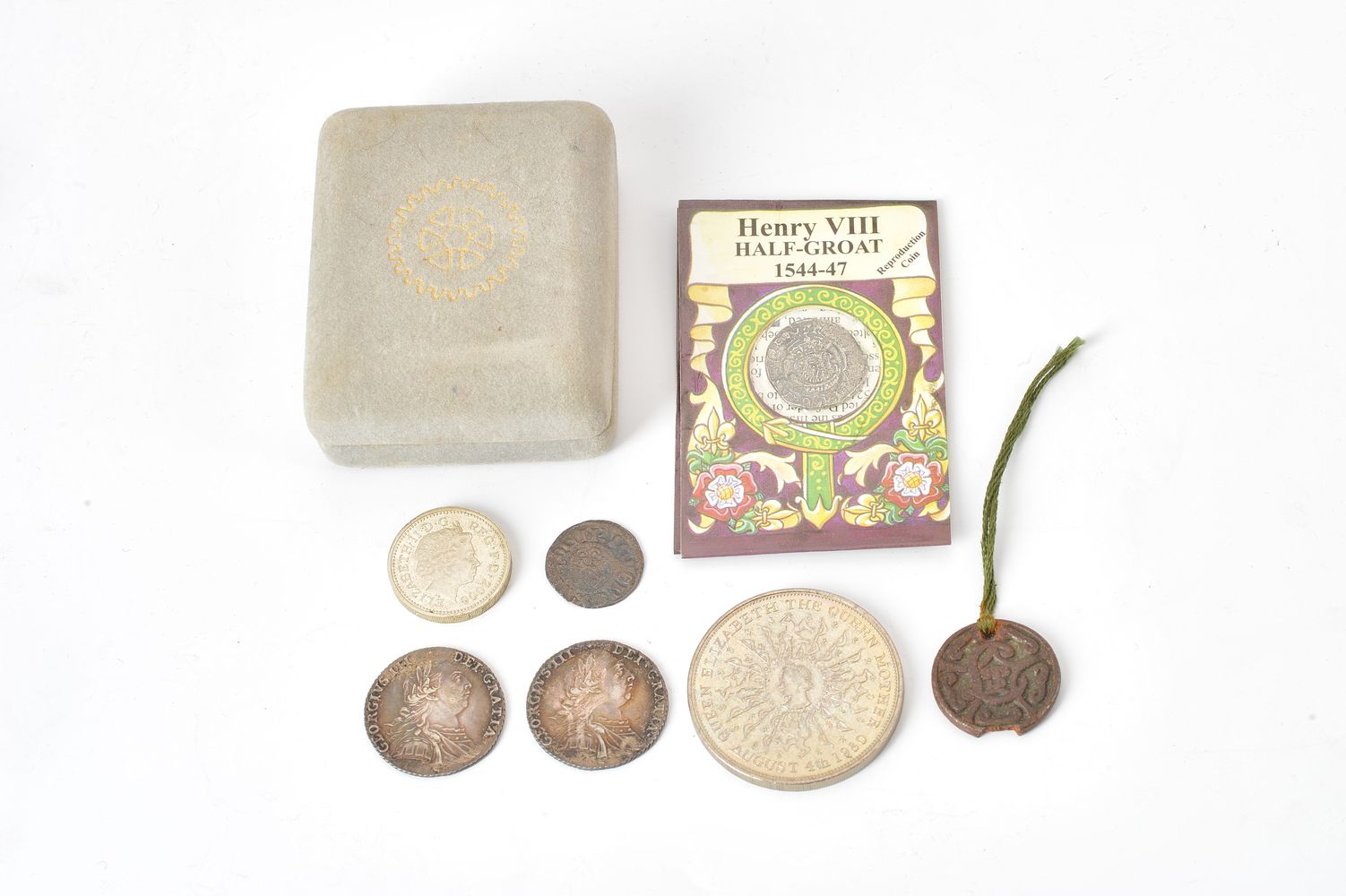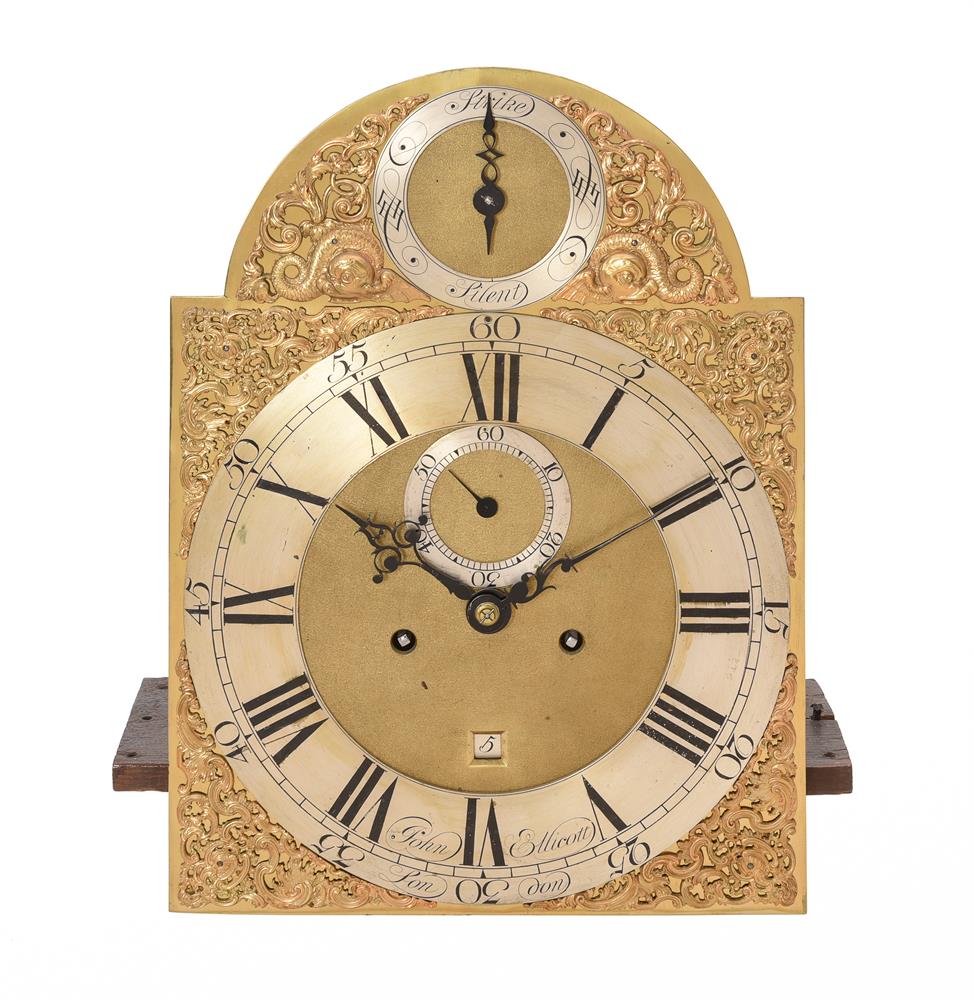A fine George III mahogany longcase clock with dual Julian and Gregorian calendar indication and deadbeat escapement George Lindsay with movement attributed to the workshop of George Graham London, circa 1752substantial fully latched five pillar rack and bell striking movement with plates measuring 8.5 x 7.25 inches, deadbeat escapement and currently of month duration with five-wheel trains, the 12 inch brass break-arch dial with dual Julian and Gregorian date of the month apertures and subsidiary seconds dial to the matted centre within applied silvered Roman numeral chapter ring with fleur-de-lys half hour markers and Arabic five minutes to outer track, the angles applied with fine female mask and scroll cast gilt spandrels beneath arch centred with a silvered boss signed George Lindsay LONDON flanked by dolphin cast mounts, the case with convex sided upstand incorporating brass foliate engraved sound fret infill to frieze and mahogany ball finials above break-arch cavetto cornice and free-standing large diameter columns flanking the hood door, the trunk with break-arch one-piece mahogany door over plain plinth base with moulded double skirt and squab feet, the interior of the case inscribed in pencil 1752 KV, 241 (95ins) excluding top finial, 251cm (99ins) high overall; with a period copy of Thomas Baskett and the Assigns of Robert Basket An Act to amend an Act made in the last Seffion of Parliament (intituled, An Act for regulating the Commencement of the Year, and for correcting the calendar now in Ufe.) 1752. (2). Lindsay is recorded in Baillie, G.H. Watchmakers & Clockmakers of the World as working in London from circa 1743 until his death in 1776, as well as being a watch and clockmaker Lindsay also produced scientific instruments. In 1743 he published an advertisement for a 'Generally Portable' microscope, in another hand written trade pamphlet Lindsay refers to himself as 'Watch & Clockmaker to his Royal highness ye Prince of Wales at ye Dial near Catherine Street in ye Strand'. He was later appointed watchmaker to George III, a position he held until his death in 1776. movement of the current lot with its distinctive substantial bulbous knopped pillars, teardrop shaped pivot cocks for the under dial work and other more subtle details such as the elongated collet for the escape wheel and the suspension cheeks being screwed to the lower edge of the backcock nib, indicates that it originated from the workshop of George Graham The overall arrangement of the strikework and the impressive nature of the snail/hour wheel assembly is typical of Graham's work and can be directly compared with numerous examples of his work such as number 777 sold Christie's King Street, June 1994 (lot 483). presence of a deadbeat escapement and larger than normal plates is noteworthy suggesting that the current lot may have been devised with further refinements in mind. Originally the movement was made to run for eight-days only and was fitted with bolt and shutter maintaining power (dial has vacant slot at 3 o'clock for the shutter lever and movement has related vacant holes in the plates) however the duration has been increased with by inserting another wheel into each train and reversing the winding pulleys. The bolt-and-shutter maintaining power was removed at this time as it is would be no longer required in a long duration movement. These improvements were probably done early in the clock's life perhaps even by Lindsay himself however there is no immediate evidence to confirm this. provision of two date apertures (to give the date of the month according to both the Julian and Gregorian calendars) to the centre of the dial indicates that the current lot was made at the time when the 'new' calendar was adopted by Act of Parliament in 1752. By this time the Julian calendar had become inaccurate (due to the error in the estimation of the length of the day) causing difficulties in respect to the synchronisation of the vernal equinox and su
A fine George III mahogany longcase clock with dual Julian and Gregorian calendar indication and deadbeat escapement George Lindsay with movement attributed to the workshop of George Graham London, circa 1752substantial fully latched five pillar rack and bell striking movement with plates measuring 8.5 x 7.25 inches, deadbeat escapement and currently of month duration with five-wheel trains, the 12 inch brass break-arch dial with dual Julian and Gregorian date of the month apertures and subsidiary seconds dial to the matted centre within applied silvered Roman numeral chapter ring with fleur-de-lys half hour markers and Arabic five minutes to outer track, the angles applied with fine female mask and scroll cast gilt spandrels beneath arch centred with a silvered boss signed George Lindsay LONDON flanked by dolphin cast mounts, the case with convex sided upstand incorporating brass foliate engraved sound fret infill to frieze and mahogany ball finials above break-arch cavetto cornice and free-standing large diameter columns flanking the hood door, the trunk with break-arch one-piece mahogany door over plain plinth base with moulded double skirt and squab feet, the interior of the case inscribed in pencil 1752 KV, 241 (95ins) excluding top finial, 251cm (99ins) high overall; with a period copy of Thomas Baskett and the Assigns of Robert Basket An Act to amend an Act made in the last Seffion of Parliament (intituled, An Act for regulating the Commencement of the Year, and for correcting the calendar now in Ufe.) 1752. (2). Lindsay is recorded in Baillie, G.H. Watchmakers & Clockmakers of the World as working in London from circa 1743 until his death in 1776, as well as being a watch and clockmaker Lindsay also produced scientific instruments. In 1743 he published an advertisement for a 'Generally Portable' microscope, in another hand written trade pamphlet Lindsay refers to himself as 'Watch & Clockmaker to his Royal highness ye Prince of Wales at ye Dial near Catherine Street in ye Strand'. He was later appointed watchmaker to George III, a position he held until his death in 1776. movement of the current lot with its distinctive substantial bulbous knopped pillars, teardrop shaped pivot cocks for the under dial work and other more subtle details such as the elongated collet for the escape wheel and the suspension cheeks being screwed to the lower edge of the backcock nib, indicates that it originated from the workshop of George Graham The overall arrangement of the strikework and the impressive nature of the snail/hour wheel assembly is typical of Graham's work and can be directly compared with numerous examples of his work such as number 777 sold Christie's King Street, June 1994 (lot 483). presence of a deadbeat escapement and larger than normal plates is noteworthy suggesting that the current lot may have been devised with further refinements in mind. Originally the movement was made to run for eight-days only and was fitted with bolt and shutter maintaining power (dial has vacant slot at 3 o'clock for the shutter lever and movement has related vacant holes in the plates) however the duration has been increased with by inserting another wheel into each train and reversing the winding pulleys. The bolt-and-shutter maintaining power was removed at this time as it is would be no longer required in a long duration movement. These improvements were probably done early in the clock's life perhaps even by Lindsay himself however there is no immediate evidence to confirm this. provision of two date apertures (to give the date of the month according to both the Julian and Gregorian calendars) to the centre of the dial indicates that the current lot was made at the time when the 'new' calendar was adopted by Act of Parliament in 1752. By this time the Julian calendar had become inaccurate (due to the error in the estimation of the length of the day) causing difficulties in respect to the synchronisation of the vernal equinox and su















Try LotSearch and its premium features for 7 days - without any costs!
Be notified automatically about new items in upcoming auctions.
Create an alert